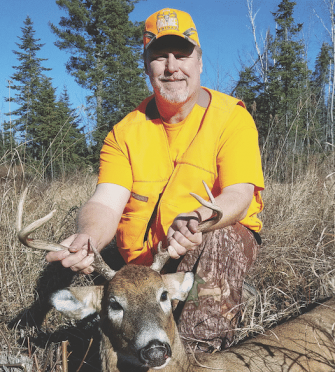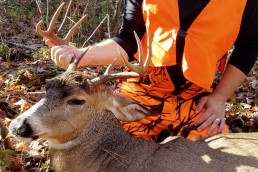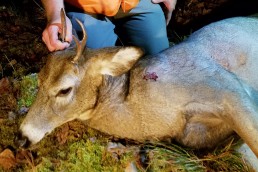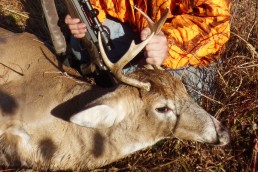Day 13 in Deer Camp 2016
SHARE THIS POST
It felt good to be lying in my sleeping bag at 8 a.m., a day off from getting up at 4 a.m. It was “break camp” day. But some of us weren’t ready to quit hunting just yet. At 4 a.m., my son Dave and grandson Tyler had gotten up at our “usual” time for a short final attempt to meet a monster buck that had been spotted northwest of camp a few days earlier.
This year (in 2016), hunting conditions were about as challenging as our previous firearm hunting season. Deer numbers were still at their lowest since 1990 (about 6 per square-mile), daytime temperatures had been in the ruinous 50s, 60s and even the 70s with winds exceeding 15 mph and gusts up to 35 mph throughout our first eight days. As could be expected, most whitetails refused to budge from their secluded beds during daylight hours. Shots heard in our region were, again, few and far between from memory. After two days of this, most other deer hunters in our region had gone home.
We didn’t give up.
Determined to keep from experiencing another dismal hunting season like in 2015, we prepared for this firearm-hunting season by scouting like we had never scouted before. My son John and I went out eight days (two trips) in mid-October. Following one long weekend of scouting by my sons Ken and Dave and grandson Tyler, Dave scouted twice more, also checking his trail cams. Few deer and falling leaves made it difficult to find the mature-buck-sized tracks and droppings we had previously scouted for before and during our hunting season. And, the unusually warm weather had once again kept the bucks from making ground scrapes and antler rubs. Nonetheless, by the third week in October we had selected several never-before-used stand sites in areas frequented by six mature bucks for the entire gang—locations revealed by lots of old and fresh droppings, especially in and around known feeding areas. Three of the bucks were certain to be trophy-class, being dominant breeding bucks.

From opening morning on, we got up at 4 a.m. daily to avoid missing even a minute of stand-hunting during the first three legal shooting hours of each day—and, while temperatures were still at their lowest and before the winds exceeded 15 mph. As has long been our custom, we always sat downwind within sight of fresh signs by mature whitetails. This year, due to the lack of snow and the difficultly of finding and assessing tracks of mature bucks on the dry, leaf-covered ground, we began keying on fresh (shiny) more commonly discovered 1/2-inch-long droppings made by mature does (some made by yearling bucks) adjacent to known feeding areas, hoping to end up-close with a doe in heat accompanied by a dominant breeding buck.
Our extra scouting had paid off, although in a different way. The unusually high temperatures during October and November had not only kept our three dominant bucks from exerting themselves by making scrapes and rubs, but had also apparently induced them to forgo their usual task of chasing lesser bucks from their breeding ranges. Though there were fewer of them, sightings of 1 1/2- to 3 1/2-year-old bucks were more common than during previous hunting seasons, and deer we had decided not to pass up this year. The 8-pointer Ken took opening morning had been feeding on acorns near the upwind edge of a large patch of scrubby red oaks where he had discovered its clumped 3/4-inch droppings while scouting three weeks earlier. The yearling buck Dave took shortly after sunset the next day had been feeding on green, thin-bladed grasses near the edge of a clear-cut where he had discovered fresh 1/2-inch droppings while scouting. The 5-pointer taken by John on day five was returning to a bedding spot at the edge of a clear-cut, where its fresh tracks and clumped droppings had attracted my attention weeks earlier.
Unexpectedly, our whitetails had not switched from feeding on green grasses to feeding on thin, woody stems of various shrubs and young trees by the end of the first week of November, as is customary in northern Minnesota, likely due to another change wrought by the unusual weather and/or limited snowfall. Tipped off by a lack of ragged white tips on stems of favored red-bark dogwoods, we quickly made it a point to key on feeding areas with green grasses where fresh tracks and droppings of whitetails had been discovered in October.
Are you enjoying this post?
You can be among the first to get the latest info on where to go, what to use and how to use it!
Though we had thus far failed to take our usual four to five mature bucks—our self-imposed limit to prevent overhunting of bucks, at least one of which is usually a trophy-class dominant breeding buck—at this point we certainly weren’t disappointed. Under the circumstances, a three-buck season was very acceptable. Moreover, trimmings of venison from three bucks would make a hefty pile of homemade smoked Polish sausages, year-round treats enjoyed by our family.
At 10:15, while John and I were packing camp items in our vehicles and trailer, Dave and Tyler suddenly popped up over the hill just north of camp with “we-got-a-buck” grins on their faces.
“I need your plastic toboggan,” Dave said.
“You got one?” I inquired.
“Yup,” Dave answered, “a nice 6-pointer. About 9 a.m., a doe and a yearling buck bounded past my stand, about 100 yards away (probably fleeing from our local wolf pack or maybe a dominant breeding buck furious about finding a young buck with one of its does). About one half hour later, I spotted a second buck bounding along the same trail. At first I merely watched it, thinking it was another yearling, but then I noticed it had a spread wider than its body and some decent bulk in its main beams. I raised my rifle and took aim, holding off firing until the moment the buck entered a clear opening. When I fired, it immediately crashed to the ground. It was one heck of a shot under the circumstances. The buck is a 3 1/2-year-old deer, about the same size as the one Ken got opening morning.”
“Congratulations,” I said, shaking Dave’s hand. “You and your two brothers certainly made this hunt another fine Nordberg buck hunting season. This year, it took exceptional knowledge, hunting skills and perseverance to do it—you three are great buck hunters.”
MWO
SHARE THIS POST
Did you enjoy this post?
You can be among the first to get the latest info on where to go, what to use and how to use it!
Dr. Ken Nordberg
Based on his 55 years of field research, Dr. Ken Nordberg has written more than 800 magazine articles, 12 books on whitetails—including the famous Whitetail Hunter’s Almanac series—five books on black bear hunting and produced Buck and Bear Hunting School videos. You may peruse his encyclopedic website with whitetail hunting tips: drnordbergondeerhunting.com, his blog: drnordbergondeerhunting.wordpress.com, or social media pages.



